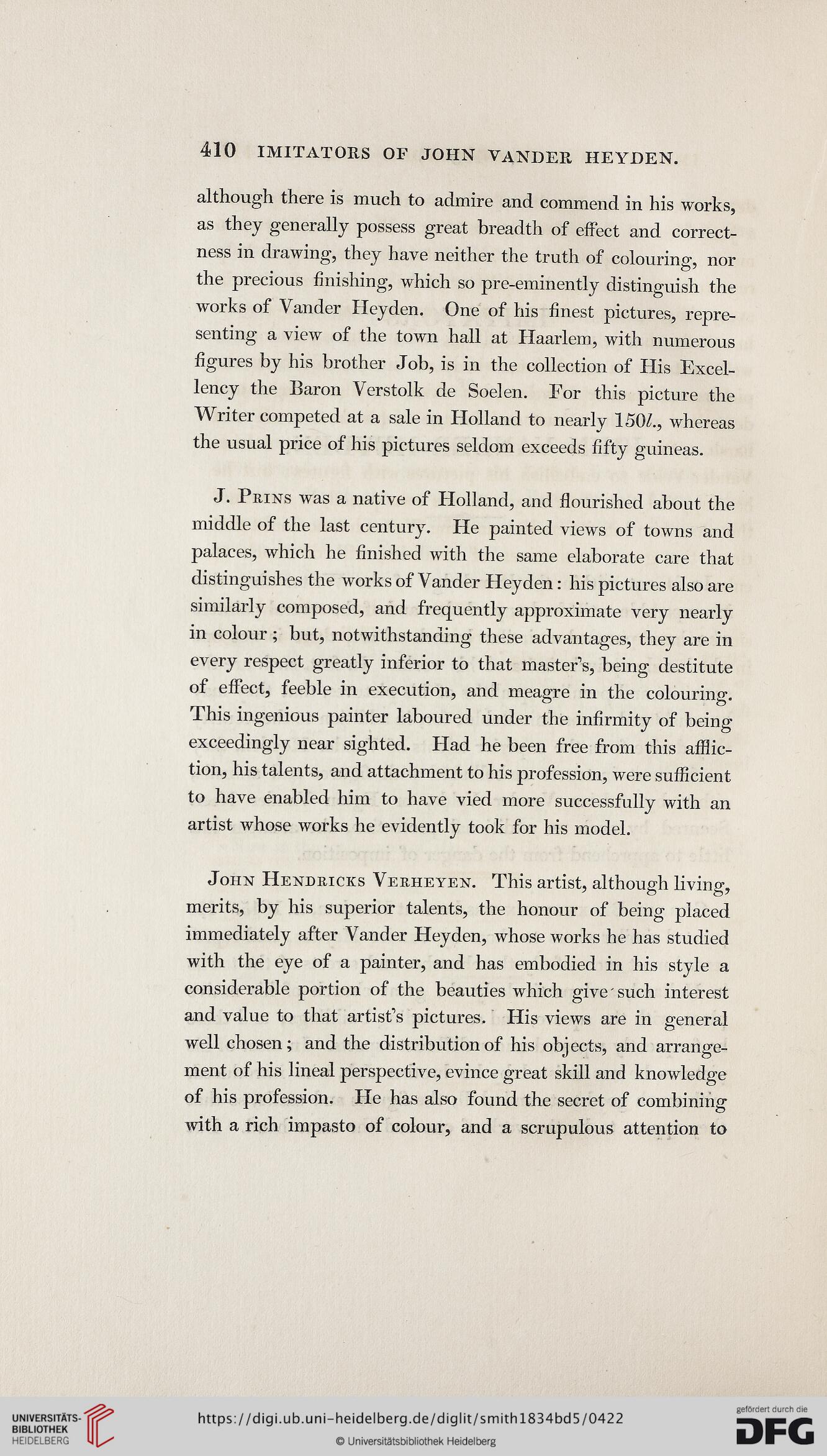410 IMITATORS OF JOHN VANDER HEYDEN.
although there is much to admire and commend in his works,
as they generally possess great breadth of effect and correct-
ness in drawing, they have neither the truth of colouring, nor
the precious finishing, which so pre-eminently distinguish the
works of Vander Heyden. One of his finest pictures, repre-
senting a view of the town hall at Haarlem, with numerous
figures by his brother Job, is in the collection of His Excel-
lency the Baron Verstolk de Soelen. For this picture the
Writer competed at a sale in Holland to nearly 150L, whereas
the usual price of his pictures seldom exceeds fifty guineas.
J. Prins was a native of Holland, and flourished about the
middle of the last century. He painted views of towns and
palaces, which he finished with the same elaborate care that
distinguishes the works of Vander Heyden: his pictures also are
similarly composed, and frequently approximate very nearly
in colour; but, notwithstanding these advantages, they are in
every respect greatly inferior to that master’s, being destitute
of effect, feeble in execution, and meagre in the colouring.
This ingenious painter laboured under the infirmity of being
exceedingly near sighted. Had he been free from this afflic-
tion, his talents, and attachment to his profession, were sufficient
to have enabled him to have vied more successfully with an
artist whose works he evidently took for his model.
John Hendricks Verheyen. This artist, although living,
merits, by his superior talents, the honour of being placed
immediately after Vander Heyden, whose works he has studied
with the eye of a painter, and has embodied in his style a
considerable portion of the beauties which give such interest
and value to that artist’s pictures. His views are in general
well chosen; and the distribution of his objects, and arrange-
ment of his lineal perspective, evince great skill and knowledge
of his profession. He has also found the secret of combining
with a rich impasto of colour, and a scrupulous attention to
although there is much to admire and commend in his works,
as they generally possess great breadth of effect and correct-
ness in drawing, they have neither the truth of colouring, nor
the precious finishing, which so pre-eminently distinguish the
works of Vander Heyden. One of his finest pictures, repre-
senting a view of the town hall at Haarlem, with numerous
figures by his brother Job, is in the collection of His Excel-
lency the Baron Verstolk de Soelen. For this picture the
Writer competed at a sale in Holland to nearly 150L, whereas
the usual price of his pictures seldom exceeds fifty guineas.
J. Prins was a native of Holland, and flourished about the
middle of the last century. He painted views of towns and
palaces, which he finished with the same elaborate care that
distinguishes the works of Vander Heyden: his pictures also are
similarly composed, and frequently approximate very nearly
in colour; but, notwithstanding these advantages, they are in
every respect greatly inferior to that master’s, being destitute
of effect, feeble in execution, and meagre in the colouring.
This ingenious painter laboured under the infirmity of being
exceedingly near sighted. Had he been free from this afflic-
tion, his talents, and attachment to his profession, were sufficient
to have enabled him to have vied more successfully with an
artist whose works he evidently took for his model.
John Hendricks Verheyen. This artist, although living,
merits, by his superior talents, the honour of being placed
immediately after Vander Heyden, whose works he has studied
with the eye of a painter, and has embodied in his style a
considerable portion of the beauties which give such interest
and value to that artist’s pictures. His views are in general
well chosen; and the distribution of his objects, and arrange-
ment of his lineal perspective, evince great skill and knowledge
of his profession. He has also found the secret of combining
with a rich impasto of colour, and a scrupulous attention to




